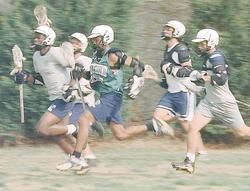 March 28, 2002 — Lacrosse is North America’s oldest sport. You would think, then, that most people would have heard of it by now.
March 28, 2002 — Lacrosse is North America’s oldest sport. You would think, then, that most people would have heard of it by now.
That’s not the case in Northeast Georgia. Even though lacrosse was played religiously here by the Cherokee, Creek and Oconee Indian tribes hundreds of years ago (the town of Ball Ground, in fact, was named for the sport), most local folks don’t know the difference between lacrosse and Lamaze.
But Riverside Military Academy hopes to change all of that. The private boarding school added lacrosse to its lineup of varsity sports this spring, becoming the first area school to do so. In fact, the closest school on the Eagles’ schedule is some 40 miles away.
Forty cadets — approximately 10 percent of RMA’s student body — tried out for the first lacrosse team in school history. Most of them had never picked up a lacrosse stick before.
“I had heard about it, but I had never seen it or anything,” Bart Mayers, a junior from Jacksonville, Fla., said. “I just thought it was some stupid guys just throwing a ball. I had no idea. Until you play, you really don’t know how cool a sport it is.”
Mayers admitted he’s still learning lacrosse, even though the Eagles’ season is now coming to an end. Still, he, like each of his teammates, is considered a resident expert at Riverside.
“A lot of the cadets are fascinated because they’ve never seen a sport like this,” Mayers said. “It’s really new to everybody. Everybody asks a lot of questions.”
Answering the questions isn’t always easy. I learned that when I was quizzing Riverside coach Joel Coleman prior to my participation in a practice last week.
Lacrosse can be hard to describe. When talking to me, Coleman likened lacrosse to football, baseball, soccer, hockey and basketball.
Finally, he said, “It’s really a combination of every game that I can think of. It’s not really a cross, it’s an amalgamation of a whole bunch of different things. It’s just a really fun sport. If you could pick out whatever you liked about any sport, that’s what lacrosse is.”
Lacrosse is played on a field close in size to the ones used for soccer. The strategy is similar to that of any sport played with one ball and two goals: Try to score more than your opponent.
What makes lacrosse unique is that the fundamentals, the basics of the game, are the most difficult skills to master. Learning how to pass and catch can take weeks, months even. Some people, even very gifted athletes, never get the hang of it.
Imagine playing hockey without knowing how to skate, or soccer without knowing how to kick.
“To kids who have never seen it before,” said Coleman, who grew up playing lacrosse in Maryland, “it’s like trying to teach them how to walk on Mars. We started practice on the 28th of January and most of them couldn’t even throw and catch. Now they look like they know what they’re doing — for the most part.”
Stick-work is the key to lacrosse. You pass, catch and scoop the ball using a long stick, called a crosse, that has a net pocket on one end. Only the goalies are allowed to use their hands.
It’s hard to get the depths down. Consider trying to catch a baseball with your glove stuck on the end of a broomstick.
“You’ll probably do better than I did my first day,” sophomore Falcon Layton, of Colorado said to me as we walked to the practice field. “I got hit by the ball.”
That can be painful. The lacrosse ball is a tad smaller than a baseball and made of solid rubber.
It’s not just the ball lacrosse players must worry about, either. Lacrosse is a very physical sport, with body checks and stick checks.
 In fact, the word American Indians in the Southeast used to describe lacrosse translates into “little brother of war.”
In fact, the word American Indians in the Southeast used to describe lacrosse translates into “little brother of war.”
Therefore, helmets, mouthpieces and shoulder pads are mandatory. Arm pads, rib pads and protective cups are highly recommended.
Coleman helped me don my body armor before the practice. I felt like an extra in that futuristic Backstreet Boys video from a few years back. I think it was for the song “Larger Than Life.” (Note: If you were born prior to 1980, just imagine a “Star Wars” stormtrooper.)
Coleman told me that the day’s practice was going to be an easy one. The team was scheduled to have its fifth match of the season the following day.
I’d hate to see Coleman’s idea of a hard practice. I was wasted after “warm-ups.”
Running with a helmet on is like carrying a sauna around on your shoulders. I’d say it got heavy, if it didn’t make me so lightheaded.
One running drill in particular put me over the edge. It’s called the “Indian run.” The team jogs single file. The person at the end of the line must sprint to the front. And so on, and so on.
I thought we were just going around our practice field … until we started going around the adjacent field, too. That’s fine, I thought … until we started running around the baseball field after that.
I figured we must have been headed to a far-off water fountain, or maybe a swimming pool. We weren’t.
“I think we got (a water break) yesterday,” said junior Don Taylor, of Hilton Head, S.C., “and I think that was the first time all season we had one. And that was because people were about to throw up.”
I figured journalists are out of Coleman’s jurisdiction. So I ducked out during the next part of practice and drank from a nearby hose.
All the running is not without reason, however. That’s what players do in a game.
“It came as a surprise,” said Malachi Dodge, a sophomore from Athens. “It was a lot faster paced than I thought it would be. In a game, it’s nonstop unless the ball goes out of bounds.”
The Eagles are 2-3 heading into spring break. Not too shabby for beginners.
They defeated South Cobb, another first-year team, 16-0. Sprayberry forfeited to Riverside last week.
“It’s surprising,” said Taylor, one of the few Riverside players with previous lacrosse experience. “Our team picked it up quick and we’ve been able to hang with a lot of the teams. We go into games thinking we’re a first-year team. But after a while, we realize that we’re as good as they are as long as we put the effort in.”
At the Academy, like any rookie squad, the lacrosse team is paying its dues. When I asked one of the cadets why we were practicing on a spotty field that had patches of gravel, he told me it was because they didn’t want to tear up their game field.
Meanwhile, the long-standing Riverside soccer team was practicing over on the lacrosse field, tearing it up.
“We’re earning our respect,” Taylor said, noting that attendance at their matches has increased dramatically since the start of the season. “Gradually, people are starting to pick it up. They’re like, ‘Oh, that looks fun. I’m going to play next year.'”
